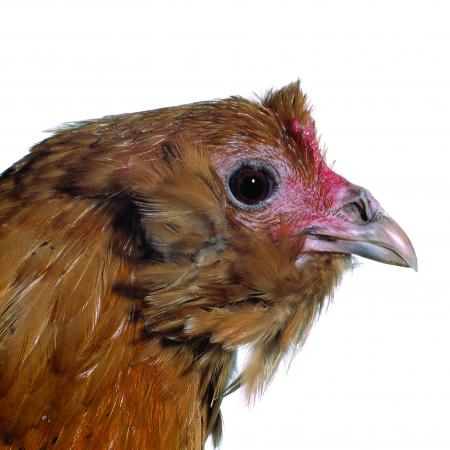
Mechelse Dresdner
CCP
The various phenotypes display characteristics of the five different chicken breeds that were crossed into this generation of the Cosmopolitan Chicken Project / recognisable traits from Belgium, France, Great Britain, the United States, and Germany.

Uilebaard
The Netherlands
The ‘Uilebaard’ (Owlbeard) is already seen on paintings by Jan Steen (17th century) / rare breed / related to the crested fowl, hence the small tuft of feathers on top of the head and at the upstanding nostrils / other typical characteristics: beard and horny comb (roosters) / white eggs / very strong breed / because it’s an old Dutch breed and if kept under strict hygienic conditions, it does not need to be culled during an outbreak of bird flu / many colour varieties - the 'moorkop' variety only occurs in Owlbeards.
Expedition
The first specimens of the Uilebaard that join the CCP for crossbreeding were bought in the Netherlands, near Arnhem.
Birthplace of the first chicks
Meeuwen-Gruitrode, on Koen Vanmechelen's home farm, in the middle of an outbreak of bird flu
First showing
Cosmopolitan Chicken Project – Mechelse Uilebaard
GEM, Den Haag (NL)/ KunstRAI, 2003
The unexpected, the appeal of the chicken
Serendipity at work...
Born during an outbreak of bird flu, the Mechelse Uilebaard was not permitted to be transported for a long time. This is how the idea arose to start stocking and storing the DNA of all chickens in the CCP. The semen of all Cosmopolitan roosters living at that time was frozen, a high-tech operation performed by scientists associated with the project. This was the start of the Frozen Culture project, a totally new experiment, both in art and in the domain of genetics. Initially, notions about cultural and genetic diversity were central to the CCP, but now Vanmechelen, forced by circumstance, started anchoring the project in science. Vanmechelen also sped up the creation of outposts at various locations in the world, where he made ‘genetic backups’ of his cosmopolitan chickens.
